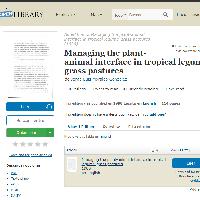Resumen
- 'Pensacola' bahiagrass ( Pasoalum notatum Flugge) is the most widely used perennial grass for summer grazing in Florida; however, animal performance from this grass is low. Overseeding bahiagrass (B) pastures with the summer annual legume Aeschvnomene americana L. may improve the nutritive value of B pastures but pasture -management practices may influence the quantity of legume in the pasture and in the diet of grazing cattle. Grazing management [rotational (RG) vs. continuous (CG) grazing] of B and bahiagrass -aeschynomene (BA) pastures was studied by investigating the plant-animal interface during grazing of these pastures by cattle. Animal defoliation effects during rotational grazing were studied by sampling both before (BRG) and after (ARG) rotational grazing. Overseeding B pastures with aeschynomene increased forage crude protein (CP), particularly in the grazing horizon. Herbage mass (HM) was greater for BRG than for CG. Forage in vitro organic matter digestion (IVOMD) was greater for RG than for CG. Greater grass-leaf percentage in both pasture types and higher legume percentage in BA pastures were found for RG than for CG. In BA pastures, highest forage CP concentration was observed for BRG when legume percentage was highest. Diet CP concentration of animals on BA pastures was 46% higher than that of animals on B pastures. For RG, diet CP was reduced by animal defoliation so that the level for ARG was similar to that for CG. Animals consumed a diet higher in IVOMD during RG than CG. Animals on BA pastures obtained a smaller bite weight (BW) than did those on B pastures. Intake per minute (IPM) , however, was not different because presence of legume increased bites per minute (BPM) , which compensated for the smaller BW. Animals obtained greatest BW when sampling BRG. For ARG, however, BW was reduced to a level similar to that for CG. The IPM was greatest for BRG. A depression in BPM for ARG, however, depressed IPM to a level even lower than that for CG. Aeschynomene increases forage nutritive value of B pastures. Grazing BA pastures rotationally gives animals the opportunity for a greater intake of forage of higher nutritive value compared to continuous grazing. Greater intake of greater nutritive value forage, however, is obtained only during the first part of the rotational grazing period. Therefore, maximum benefit will be obtained if high- producing animals grazed these pastures first and they are removed to a new paddock before severe defoliation of the legume occurred.
